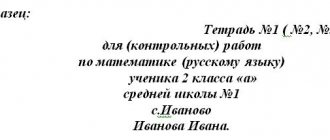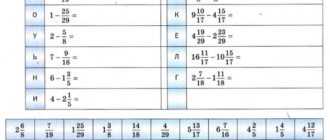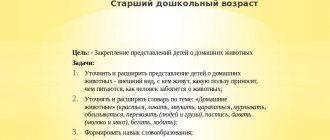Summary of the Russian language lesson “Description of actions” (grade 7)
Lesson 77. Description of actions
Goals: improve the skills of written monologue speech; learn to create your own text based on reference diagram 3 “Description of actions”; observe the role of adverbs in describing a labor action; develop attention to the person and his work.
Personal UUD.
Personal and professional self-determination.
Cognitive UUD.
Analysis of phenomena.
Construction of a speech utterance. Communicative UUD
. The ability to express one’s thoughts with sufficient completeness and accuracy. Mastery of monologue and dialogic forms of speech.
During the classes
- Motivational start to the lesson.
Teacher's word.
During the lesson you will have to work on an essay - a description of actions, a work process. The key lexical units of such an essay are verbs, gerunds (describe the main and additional actions) and adverbs (denote the sequence and quality of actions). In the text, it is important to convey the sequence of actions, what was done first and what was done next; it is important to convey the attitude of the master to his work, the attitude of the author of the essay to the observed process.
- Working with the textbook.
Ex. 260.
Students read, answer questions;
copy down the text, giving it a different title. (Name options: “The work of a master”
,
“The skill of a carpenter
.”) Name the adverbs involved in the description of actions.
Execution is independent, after which a check occurs. (Adverbs with which the author “depicts” actions: best of all
,
quickly
,
evenly
. Adverbs with which the author indicates the sequence of actions:
first
,
then
.)
- Working with support diagram 3 “Description of actions”.
Conversation on questions:
— Do you understand what parts the essay consists of? How to construct sentences in the main part that describes the action itself?
— What words are used to convey the sequence of the labor process?
- Reading and analyzing a sample essay - a description of an action.
Magic rope
(1) To make my birthday memorable for the guests, I decided to organize a “Magic Rope” game. (2) For this I needed many small prizes. (3) First, I wrapped each item in gift paper, then tied it tightly with thick thread and carefully hung it on a ribbon stretched from wall to wall.
(4) The birthday came, the treat was eaten, and it was time to play. (5) I blindfolded all the guests in turn and handed out scissors. (6) Having spun the man around his axis, I quickly brought him to the rope. (7) Taking the first bundle he came across, the guest cut it off.
(8) At the end of the game, someone received a keychain, and someone received a pen with the image of cartoon characters. (9) The rope really turned out to be magical. (10) I gave my friends not only souvenirs, but also a good mood.
(According to the Encyclopedia of Family Celebrations)
- Conversation on questions:
— What does the introduction say?
— How many paragraphs does the main part consist of? Identify a micro-topic for each paragraph. (Preparation for the game; actions during the game.)
- Find the verbs in sentences 3, 5, 6, 7. What do they mean? (These words name the actions performed, the stages of implementation of the plan.)
— What questions of reference diagram 3 does the final part answer?
— From the text, write down the adverbs: a) conveying a sequence of actions; b) characterizing the work of the performer and his attitude towards it.
- Summing up the lesson.
— What new did you learn in the lesson?
— In what cases does it become necessary to describe an action?
— What parts of speech words are key when describing actions? (Verbs describing the main action. Participles describing an additional action. Adverbs characterizing actions.)
- Homework.
Ex. 263 or 264. Write an essay using reference diagram 3.
SUPPORT DIAGRAM 3
DESCRIPTION OF ACTIONS
1. Introduction.
- What action will be described in the essay? Who performs this action? Think about why you decided to describe this particular action. Why is the action being performed? What is the expected result? Does the performer wear a uniform ( apron)
,
robe
,
robe
,
protective suit
,
headdress
)?
I decided to do...
I like to watch...
The craftsmanship is amazing...
You often see...
2. Description of the sequence of actions.
— What are the names of the master's tools? How is his workplace equipped? What was done first in the process of labor actions, what then? What especially attracts attention in the work of the master?
I (or indicate the name of the master or profession) did, performed...
I (a master, a representative of the profession) needed, needed, had to...
After that it's done...
Then you had to do...
The key vocabulary of the essay is verbs, gerunds and adverbs.
When working, it is useful to write down the order of actions in the draft: 1)… 2)… 3)…
3. Conclusion.
— Are the results of your work impressive? Does he make people happy? What do you think are the thoughts and experiences of someone who worked? Is it possible to say about such a person that “the master’s work is afraid”?
- Adverbs to describe a sequence of actions:
first, first, immediately, immediately, then, then, after, several (times), in turn, finally, again.
- Adverbs to describe the nature of actions:
quickly, evenly, deftly, firmly, strongly, slightly, slightly, masterfully, skillfully.
- Adverbs to describe the attitude of a master to his work:
diligently, carefully, thoughtfully, neatly, carefully, persistently, cautiously, confidently, enthusiastically, calmly, professionally, carefully.
SAMPLE ESSAY - DESCRIPTION OF AN ACTION.
Magic rope
(1) To make my birthday memorable for the guests, I decided to organize a “Magic Rope” game. (2) For this I needed many small prizes. (3) First, I wrapped each item in gift paper, then tied it tightly with thick thread and carefully hung it on a ribbon stretched from wall to wall.
(4) The birthday came, the treat was eaten, and it was time to play. (5) I blindfolded all the guests in turn and handed out scissors. (6) Having spun the man around his axis, I quickly brought him to the rope. (7) Taking the first bundle he came across, the guest cut it off.
(8) At the end of the game, someone received a keychain, and someone received a pen with the image of cartoon characters. (9) The rope really turned out to be magical. (10) I gave my friends not only souvenirs, but also a good mood.
(According to the Encyclopedia of Family Celebrations)
Summary of a lesson in the Russian language on the topic “Speech development. Concise presentation. (7th grade)
Lesson topic :
Speech development. Control condensed presentation.
The purpose of the lesson
: expand students’ knowledge about compressed presentation, introduce text compression techniques, practice text compression skills; prepare to write a concise summary.
Planned results:
Subject: know: narrative composition; the role of keywords in the text; the meaning of paragraph division; be able to: highlight the main thing based on key words in parts of the source text, create a text of presentation, correct the created text;
Metasubject:
Personal: interest in writing, in creating your own texts;
Regulatory: independently analyze the conditions and ways to achieve the goal;
Cognitive: extract factual and subtextual information from the text; use educational reading; present the content of the read text concisely.
Communicative: edit a written statement; use language appropriately.
During the classes:
- Organizing time.
- Goal setting.
Announcing the topic and objectives of the lesson.
3. Works on the topic.
— It is important to have the ability to concisely present a text; it will be useful to you in later life: when passing an exam, when continuing your studies, in communication, in professional activities. That is why the ability to concisely present a text is given special attention in speech development lessons.
— What is a condensed presentation?
Let's compare the purpose of detailed and concise presentation.
Familiarization with text compression techniques.
Writing in a notebook.
Text compression techniques: exclusion, generalization (replacement), merging.
Let's get acquainted with the first technique - exception.
- What can be excluded? (details, details, repetitions; something that is not directly related to the topic and main idea of the text)
— Working with the first text.
- What can we exclude from it?
There are people for whom everything is always clear. It is they, in their own opinion, who are best versed in politics, medicine, education - in short, in any area of human knowledge and activity. Such “experts” are not surprised by anything, and therefore are not able to make a discovery, even the smallest one. In general, people for whom everything is clear are hopeless people.
(According to V.I. Kurbatov)
The second method of text compression is generalization (or replacement)
- How can you apply this technique? First of all, you can select (or find in the text) a common word that combines several concepts, objects, etc. listed in the text.
and
replace
several words with one word.
Let's read the text
The life of the Serov family was filled with his father’s artistic work, discussions of exhibitions, and conversations on art topics. Not only painters, but also musicians, sculptors, artists, and poets often gathered with the Serovs. Among them are actors Moskvin, Komissarov, Dobronravov, artists Efimov, Konchalovsky, Yakovlev, Krymov, musicians Neuhaus, Richter, poet Pasternak.
(According to G. Arbuzov)
And the last technique for compressing text is merging.
You can generalize several
similar statements, thoughts
(sentences), i.e., make one from several sentences.
This method is called merging.
Many argue that listening to music at home is even better than in the hall: no one whispers, no rustling candy papers, no coughing, no chairs creaking. (S. Ghazaryan)
I remember the evening before the New Year. I was six or seven years old. As a gift I received a book with Andersen's fairy tales. This is how this Danish storyteller appeared in my life (According to K. Paustovsky
— Working on a concise presentation.
Each of us once had favorite toys. Perhaps every person has a bright and tender memory associated with them, which he carefully keeps in his heart. A favorite toy is the most vivid memory from every person’s childhood. In the age of computer technology, real toys no longer attract as much attention as virtual ones. But despite all the emerging new products, such as telephones and computer equipment, the toy still remains unique and irreplaceable of its kind, because nothing teaches and develops a child more than a toy with which he can communicate, play and even acquire life skills. experience. A toy is the key to the consciousness of a little person. In order to develop and strengthen positive qualities in him, make him mentally healthy, instill love for others, form a correct understanding of good and evil, you need to carefully choose a toy, remembering that it will bring into his world not only his image, but also behavior, attributes, as well as a value system and worldview. It is impossible to raise a full-fledged person with the help of negative toys.
3 Analytical conversation on the text.
What is the text talking about?
What's the theme?
What is the main idea? For what purpose did the author write this text?
What title would you give to this text and why?
Write down the name.
Define text style? Prove it. (Publicistic, reasoning.)
What artistic means does the author use, for what purpose?
Explain spelling patterns and punctuation marks that are difficult for you in this text.
4. Writing a concise summary.
Every person has a memory associated with his favorite toy, because it is the most vivid memory of any person’s childhood. In the age of computer technology, virtual toys receive more attention than real ones. But despite the latest technology, the toy remains indispensable because it teaches and develops the child. A toy is the key to the consciousness of a little person, so you need to carefully choose a toy that will bring your image, behavior, value system and worldview into his world. You cannot raise a full-fledged person with the help of negative toys.
Download material
so UNT / Lesson plans for the Russian language / Lesson plans for the Russian language 7th grade
Lessons 77-78. Speech development. Description of actions
14.12.2011 21269 2151
Lessons 77-78. Speech development. Description of actions
Goals:
consolidate what you have learned about adverbs; show the meaning of adverbs when describing actions; expand the speech competence of students, improve monologue speech skills.
Methodical techniques:
conversation on issues, elements of text analysis, work on correcting speech errors, work on a plan, oral composition.
Progress of lessons
I. Linguistic warm-up
Word formation analysis and analysis of words by composition: masterfully
Find out about the origins of words in dictionaries.
II. Conversation about the meaning of action descriptions
Teacher's word.
We began our work on speech development with a description of a portrait and a person’s appearance. You also tried your hand at describing nature, terrain, and interiors. Today we have to learn how to describe actions. It is obvious that we cannot do this work without adverbs that will show how a person acts and works. — Do you remember descriptions of what actions you have come across in fiction? Read some of these descriptions. (For example, a description of Gerasim’s work from the story
A. M. Gorky “Childhood”: a description of Uncle Yakov playing the guitar, a description of the grandmother’s dancing, a description of the work of a master in a dyeing workshop. Etc.)
Are descriptions of actions in other styles of speech other than artistic ones appropriate? (Conversational style - a story-description, for example, of fishing, cooking, etc.
Official business style - instructions, for example, on working with various mechanisms.
Scientific style is a description of the order of actions, for example, in a scientific experiment, in laboratory work.
Journalistic style - for example, a report or interview about
any actions; most often found in sports journalism.)
Find examples of describing actions in different styles of speech.
III. Working with the textbook
1. Exercise 237: reading, discussing questions, determining the role of adverbs.
A comment.
The title of the text does not correspond to its content. Title options: “The Work of a Master,” “The Craft of a Carpenter.”
Adverbs with which the author “depicts” actions: best
, quickly, smoothly.
Adverbs with which the author indicates a sequence of actions: first, then.
2.
Exercise 238: work on correcting speech errors.
A comment,
then
is unjustifiably repeated (three times).
You can use its synonyms: then, after (after that), finally.
3. Implementation of homework (exercise 239): students’ reports about the sequence of actions of working people, about the nature of their work.
IV. Oral essay
1. Work on an essay plan.
2. Exercise:
choose adverbs that relate a) to the sequence of actions
(first, then, then, immediately, immediately, after),
b) to the characteristics of the work
(precisely, skillfully, neatly
to the attitude towards the work (
carefully, persistently, carefully, deftly, confidently, strongly, diligently, carefully).
3. Oral description of actions, discussion of descriptions.
4. Working with a draft essay.
Note.
You can give an anticipatory task: observe how adults work at work, at home (for example, how mom prepares dinner); describe the sequence of your actions and the actions of your comrades, for example, in a labor lesson.
Adverb
Homework
Write an essay - a description of actions in a journalistic style.
See the downloadable file for the full text of the material.
The page contains only a fragment of the material.




